Resource management, soil fertility and sustainable
- 格式:pdf
- 大小:405.29 KB
- 文档页数:7
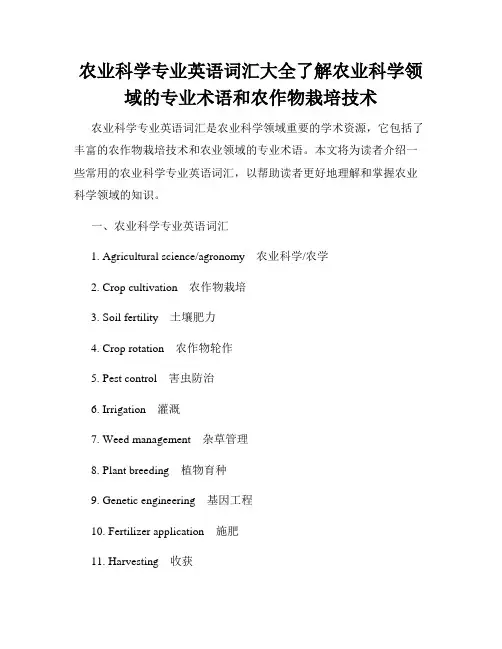
农业科学专业英语词汇大全了解农业科学领域的专业术语和农作物栽培技术农业科学专业英语词汇是农业科学领域重要的学术资源,它包括了丰富的农作物栽培技术和农业领域的专业术语。
本文将为读者介绍一些常用的农业科学专业英语词汇,以帮助读者更好地理解和掌握农业科学领域的知识。
一、农业科学专业英语词汇1. Agricultural science/agronomy 农业科学/农学2. Crop cultivation 农作物栽培3. Soil fertility 土壤肥力4. Crop rotation 农作物轮作5. Pest control 害虫防治6. Irrigation 灌溉7. Weed management 杂草管理8. Plant breeding 植物育种9. Genetic engineering 基因工程10. Fertilizer application 施肥11. Harvesting 收获12. Silage making 青贮制作13. Livestock breeding 畜牧养殖14. Dairy farming 奶牛养殖15. Poultry farming 家禽养殖16. Aquaculture 水产养殖17. Veterinary medicine 兽医学18. Agribusiness 农业经营19. Sustainable agriculture 可持续农业20. Organic farming 有机农业二、农作物栽培技术1. Soil preparation 土壤准备Soil preparation involves clearing the land, removing weeds and debris, and loosening the soil to improve its structure and drainage.2. Seed selection 种子选择Seed selection is an important step in crop cultivation. Farmers should choose high-quality seeds that are resistant to diseases and pests, and have high yield potential.3. Planting 种植Planting refers to the process of sowing seeds or transplanting seedlings into the soil. It is essential to provide the right spacing and depth for optimal plant growth.4. Fertilization 施肥Fertilization is the application of nutrients to the soil to provide essential elements for plant growth. It can be done through organic or inorganic fertilizers, depending on the specific nutrient requirements of the crop.5. Weed control 杂草防治Weeds compete with crops for nutrients, water, and sunlight. Effective weed control methods include manual weeding, the use of herbicides, and mulching to suppress weed growth.6. Pest management 害虫管理Pests can cause significant damage to crops. Integrated pest management techniques, such as biological control, cultural practices, and the judicious use of pesticides, help minimize pest damage while protecting the environment.7. Disease prevention 病害预防Crop diseases can reduce yield and quality. Disease prevention involves crop rotation, use of disease-resistant varieties, proper sanitation, and timely application of fungicides if necessary.8. Irrigation 灌溉Irrigation is essential for crop growth in areas with insufficient rainfall. It involves providing the right amount of water at the right time to ensure optimal plant health and productivity.9. Harvesting 收获Harvesting is the process of gathering mature crops for consumption or further processing. It involves careful timing to ensure maximum yield and quality.10. Storage and processing 储存和加工Proper storage and processing ensure that harvested crops remain fresh and maintain their nutritional value. This may involve drying, curing, canning, or freezing, depending on the specific crop.结语本文介绍了一些常用的农业科学专业英语词汇和农作物栽培技术,希望能帮助读者增加对农业科学领域的理解和掌握。
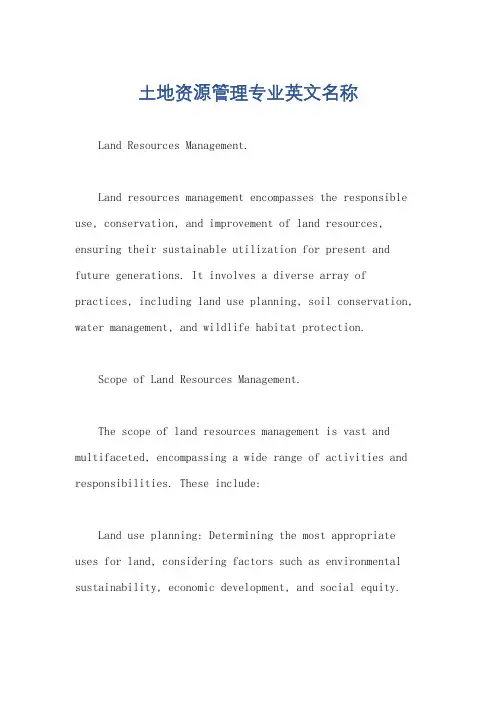
土地资源管理专业英文名称Land Resources Management.Land resources management encompasses the responsible use, conservation, and improvement of land resources, ensuring their sustainable utilization for present and future generations. It involves a diverse array of practices, including land use planning, soil conservation, water management, and wildlife habitat protection.Scope of Land Resources Management.The scope of land resources management is vast and multifaceted, encompassing a wide range of activities and responsibilities. These include:Land use planning: Determining the most appropriate uses for land, considering factors such as environmental sustainability, economic development, and social equity.Soil conservation: Implementing practices to protect and improve soil quality, prevent erosion, and maintainsoil fertility.Water management: Managing water resources to ensure their availability and quality for various uses, including agriculture, domestic consumption, and industrial purposes.Wildlife habitat protection: Conserving and restoring habitats for wildlife, ensuring the survival and diversity of plant and animal species.Rangeland management: Managing grasslands and shrublands to maintain their productivity and ecological integrity while supporting livestock grazing and other activities.Forest management: Managing forests to provide a range of benefits, including timber production, watershed protection, and recreation opportunities.Importance of Land Resources Management.Land resources are essential for human well-being, providing the foundation for food production, economic development, and environmental sustainability. Effective land resources management is crucial for:Food security: Ensuring the availability of nutritious food by sustainably managing agricultural lands.Economic prosperity: Facilitating economic growth through responsible land use planning and development.Environmental conservation: Protecting and improving ecosystems, watersheds, and wildlife habitats.Climate change mitigation: Managing land resources to reduce greenhouse gas emissions and sequester carbon.Education and Training in Land Resources Management.Professionals in land resources management typically hold degrees in natural resources, environmental science,or a related field. They receive education and training in various disciplines, including ecology, soil science, hydrology, and policy analysis. In addition to theoretical knowledge, practical experience in land management and conservation is highly valued in the field.Career Opportunities in Land Resources Management.Land resources management professionals work in various settings, including government agencies, non-profit organizations, and private companies. Career opportunities include:Land use planner: Developing and implementing land use plans and policies.Soil conservationist: Designing and implementing practices to protect and improve soil quality.Watershed manager: Managing water resources and protecting watersheds.Wildlife biologist: Conserving and managing wildlife populations and habitats.Rangeland manager: Managing grasslands and shrublands to support livestock grazing and other uses.Forest manager: Managing forests to provide timber, recreation, and environmental benefits.Conclusion.Land resources management is a critical discipline that ensures the sustainable use and conservation of land resources for present and future generations. By implementing responsible practices in land use planning, soil conservation, water management, and wildlife habitat protection, we can safeguard the integrity of our natural ecosystems and support the well-being of both human andnon-human communities.。
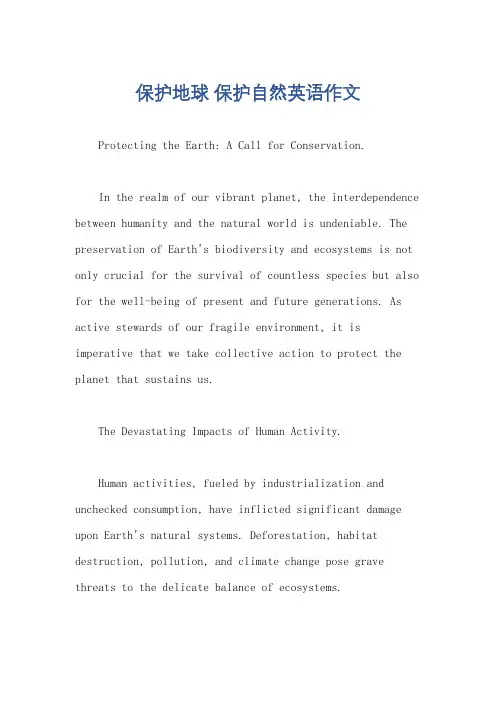
保护地球保护自然英语作文Protecting the Earth: A Call for Conservation.In the realm of our vibrant planet, the interdependence between humanity and the natural world is undeniable. The preservation of Earth's biodiversity and ecosystems is not only crucial for the survival of countless species but also for the well-being of present and future generations. As active stewards of our fragile environment, it is imperative that we take collective action to protect the planet that sustains us.The Devastating Impacts of Human Activity.Human activities, fueled by industrialization and unchecked consumption, have inflicted significant damage upon Earth's natural systems. Deforestation, habitat destruction, pollution, and climate change pose grave threats to the delicate balance of ecosystems.The loss of forests, primarily driven by deforestation for agriculture, construction, and timber extraction, contributes to biodiversity loss and ecosystem disruption. Trees perform vital functions such as absorbing carbon dioxide, regulating water cycles, and providing habitats for countless species. Their destruction has far-reaching consequences for the global climate and the livelihoods of communities dependent on forest resources.Habitat destruction, stemming from urban expansion, agriculture, and resource extraction, deprives species of their vital homes. This fragmentation and isolation of habitats lead to population declines, genetic isolation, and an increased risk of extinction. The loss of natural habitats also affects ecosystem services, such as pollination, nutrient cycling, and water purification.Pollution, a byproduct of industrialization and waste management practices, contaminates air, water, and soil. Air pollution, primarily caused by burning fossil fuels, releases harmful substances such as nitrogen oxides and particulate matter, which can lead to respiratory ailmentsand other health issues. Water pollution, resulting from industrial wastewater, agricultural runoff, and sewage discharge, pollutes waterways, harms aquatic ecosystems, and jeopardizes drinking water sources. Soil contamination, often caused by industrial chemicals, pesticides, and improper waste disposal, can damage soil fertility and pose risks to human health.Climate change, driven by the release of greenhouse gases such as carbon dioxide and methane, is alteringEarth's atmosphere and causing global temperatures to rise. This warming trend has far-reaching consequences, including melting polar ice caps, rising sea levels, extreme weather events, and disruptions to agricultural productivity. Climate change not only poses direct threats to human societies but also exacerbates the aforementioned environmental challenges, such as habitat loss and species extinction.The Imperative for Conservation.The alarming consequences of human activity on Earth'secosystems necessitate immediate and comprehensive conservation efforts. Conservation encompasses a wide range of measures aimed at protecting natural resources, preventing species extinction, and maintaining theintegrity of ecosystems.Protecting and restoring forest ecosystems is crucial for mitigating climate change, preserving biodiversity, and safeguarding watersheds. Reducing deforestation, promoting sustainable forest management practices, and reforestation initiatives can help restore forests and enhance their crucial ecological functions.Protecting habitats is essential for ensuring the survival of species and maintaining ecosystem resilience. Establishing protected areas, such as national parks, wildlife refuges, and marine reserves, provides safe havens for wildlife and helps prevent habitat fragmentation. Implementing wildlife corridors, which connect fragmented habitats, allows for species movement and genetic exchange, enhancing population viability.Reducing pollution is paramount for protecting human and environmental health. Implementing stricter regulations on industrial emissions, promoting alternative energy sources, and adopting waste reduction and recycling practices can mitigate air and water pollution. Sustainable agricultural practices, such as reducing fertilizer and pesticide use, can help protect soil health and reduce nutrient runoff.Addressing climate change requires a global commitment to reducing greenhouse gas emissions. Transitioning to renewable energy sources, such as solar, wind, and geothermal, and improving energy efficiency are crucial steps towards mitigating climate change. Additionally, investing in adaptation measures, such as coastalprotection and agricultural resilience, can help communities cope with the impacts of climate change.Education, Awareness, and Advocacy.Protecting Earth's ecosystems requires not only policy action but also a fundamental shift in our attitudes andbehaviors. Education and awareness campaigns play a vital role in fostering an understanding of environmental issues and promoting conservation practices.Incorporating environmental education into school curricula can instil in future generations an appreciation for the natural world and a sense of responsibility towards the environment. Community outreach programs, public awareness campaigns, and media coverage can raise awareness about environmental conservation and encourage people to adopt eco-friendly practices.Advocacy and activism are essential for driving policy change and mobilizing public support for conservation. Engaging with policymakers, participating in environmental organizations, and supporting conservation initiatives can amplify the voices of those advocating for the protection of Earth's ecosystems.Conclusion.The preservation of Earth's natural systems is a moraland practical imperative. The consequences of humanactivity on the planet's environment are becoming increasingly evident, posing threats to human well-being, global stability, and the survival of countless species. By implementing comprehensive conservation measures, reducing our impact on the environment, and fostering a culture of sustainability, we can protect Earth's ecosystems for generations to come, ensuring the prosperity of both humanity and the natural world.。
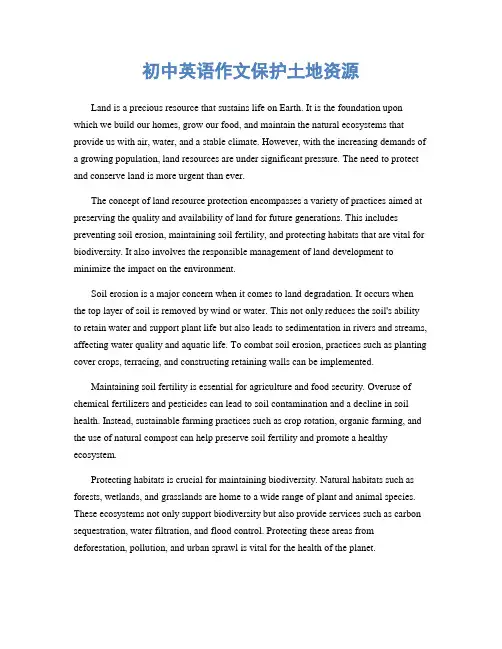
初中英语作文保护土地资源Land is a precious resource that sustains life on Earth. It is the foundation upon which we build our homes, grow our food, and maintain the natural ecosystems that provide us with air, water, and a stable climate. However, with the increasing demands of a growing population, land resources are under significant pressure. The need to protect and conserve land is more urgent than ever.The concept of land resource protection encompasses a variety of practices aimed at preserving the quality and availability of land for future generations. This includes preventing soil erosion, maintaining soil fertility, and protecting habitats that are vital for biodiversity. It also involves the responsible management of land development to minimize the impact on the environment.Soil erosion is a major concern when it comes to land degradation. It occurs when the top layer of soil is removed by wind or water. This not only reduces the soil's ability to retain water and support plant life but also leads to sedimentation in rivers and streams, affecting water quality and aquatic life. To combat soil erosion, practices such as planting cover crops, terracing, and constructing retaining walls can be implemented.Maintaining soil fertility is essential for agriculture and food security. Overuse of chemical fertilizers and pesticides can lead to soil contamination and a decline in soil health. Instead, sustainable farming practices such as crop rotation, organic farming, and the use of natural compost can help preserve soil fertility and promote a healthy ecosystem.Protecting habitats is crucial for maintaining biodiversity. Natural habitats such as forests, wetlands, and grasslands are home to a wide range of plant and animal species. These ecosystems not only support biodiversity but also provide services such as carbon sequestration, water filtration, and flood control. Protecting these areas from deforestation, pollution, and urban sprawl is vital for the health of the planet.Responsible land development is key to balancing human needs with environmental protection. This involves careful planning to ensure that new developments are sustainable and do not encroach on important natural areas. Smart growth strategies, such as building up rather than out, can help reduce the footprint of urban expansion and preserve open spaces.Education and awareness are also important components of land resource protection. By educating the public about the importance of land conservation and the steps they can take to help, we can foster a culture of stewardship that values and protects our natural resources.In conclusion, protecting land resources is a complex task that requires the cooperation of individuals, communities, and governments. Through sustainable practices, responsible development, and education, we can ensure that our land remains a viable and vibrant resource for generations to come. It is our collective responsibility to care for the Earth and safeguard its resources, for the land is not just the ground beneath our feet; it is the very foundation of life itself. 。
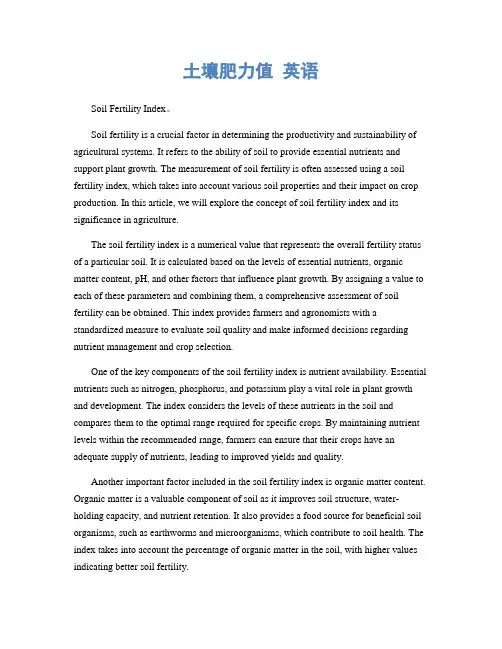
土壤肥力值英语Soil Fertility Index。
Soil fertility is a crucial factor in determining the productivity and sustainability of agricultural systems. It refers to the ability of soil to provide essential nutrients and support plant growth. The measurement of soil fertility is often assessed using a soil fertility index, which takes into account various soil properties and their impact on crop production. In this article, we will explore the concept of soil fertility index and its significance in agriculture.The soil fertility index is a numerical value that represents the overall fertility status of a particular soil. It is calculated based on the levels of essential nutrients, organic matter content, pH, and other factors that influence plant growth. By assigning a value to each of these parameters and combining them, a comprehensive assessment of soil fertility can be obtained. This index provides farmers and agronomists with a standardized measure to evaluate soil quality and make informed decisions regarding nutrient management and crop selection.One of the key components of the soil fertility index is nutrient availability. Essential nutrients such as nitrogen, phosphorus, and potassium play a vital role in plant growth and development. The index considers the levels of these nutrients in the soil and compares them to the optimal range required for specific crops. By maintaining nutrient levels within the recommended range, farmers can ensure that their crops have an adequate supply of nutrients, leading to improved yields and quality.Another important factor included in the soil fertility index is organic matter content. Organic matter is a valuable component of soil as it improves soil structure, water-holding capacity, and nutrient retention. It also provides a food source for beneficial soil organisms, such as earthworms and microorganisms, which contribute to soil health. The index takes into account the percentage of organic matter in the soil, with higher values indicating better soil fertility.Soil pH is also considered in the calculation of the fertility index. pH is a measure of the acidity or alkalinity of the soil and directly affects nutrient availability. Different crops have specific pH requirements, and the index helps determine if the soil pH is within the suitable range for optimal plant growth. Soil pH can be adjusted through the application of lime or sulfur, depending on whether the soil is too acidic or alkaline.Apart from these factors, the soil fertility index may also include parameters such as cation exchange capacity (CEC), electrical conductivity (EC), and soil texture. CEC measures the soil's ability to retain and release nutrients, while EC indicates the salt content in the soil. Soil texture refers to the proportion of sand, silt, and clay particles in the soil, which affects its water-holding capacity and nutrient retention.The soil fertility index serves as a valuable tool for farmers and researchers in managing soil resources effectively. By regularly monitoring and evaluating the fertility status of their soils, farmers can make informed decisions regarding fertilizer application, crop rotation, and soil amendments. This approach not only optimizes crop production but also minimizes the risk of nutrient imbalances, soil degradation, and environmental pollution.In conclusion, the soil fertility index is a comprehensive measure of soil quality and plays a crucial role in sustainable agriculture. It considers various factors that influence plant growth and provides a standardized assessment of soil fertility. By utilizing this index, farmers can make informed decisions to improve soil health, maximize crop productivity, and ensure long-term sustainability in agricultural systems.。
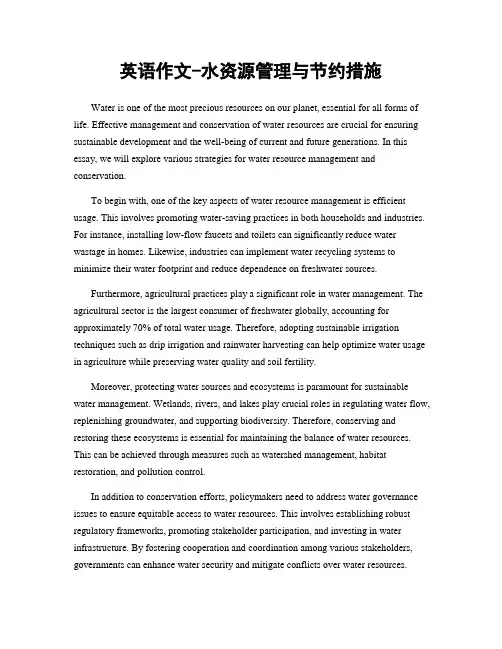
英语作文-水资源管理与节约措施Water is one of the most precious resources on our planet, essential for all forms of life. Effective management and conservation of water resources are crucial for ensuring sustainable development and the well-being of current and future generations. In this essay, we will explore various strategies for water resource management and conservation.To begin with, one of the key aspects of water resource management is efficient usage. This involves promoting water-saving practices in both households and industries. For instance, installing low-flow faucets and toilets can significantly reduce water wastage in homes. Likewise, industries can implement water recycling systems to minimize their water footprint and reduce dependence on freshwater sources.Furthermore, agricultural practices play a significant role in water management. The agricultural sector is the largest consumer of freshwater globally, accounting for approximately 70% of total water usage. Therefore, adopting sustainable irrigation techniques such as drip irrigation and rainwater harvesting can help optimize water usage in agriculture while preserving water quality and soil fertility.Moreover, protecting water sources and ecosystems is paramount for sustainable water management. Wetlands, rivers, and lakes play crucial roles in regulating water flow, replenishing groundwater, and supporting biodiversity. Therefore, conserving and restoring these ecosystems is essential for maintaining the balance of water resources. This can be achieved through measures such as watershed management, habitat restoration, and pollution control.In addition to conservation efforts, policymakers need to address water governance issues to ensure equitable access to water resources. This involves establishing robust regulatory frameworks, promoting stakeholder participation, and investing in water infrastructure. By fostering cooperation and coordination among various stakeholders, governments can enhance water security and mitigate conflicts over water resources.Another critical aspect of water resource management is raising awareness and education about water conservation. Educating the public about the importance of water conservation and providing practical tips for reducing water consumption can empower individuals to take action in their daily lives. Schools, community organizations, and media outlets can play vital roles in disseminating information and promoting behavior change.Furthermore, technological innovations offer promising solutions for water management challenges. Advanced technologies such as remote sensing, data analytics, and artificial intelligence can help monitor water quality, predict water availability, and optimize water distribution. By harnessing the power of innovation, we can develop more efficient and sustainable water management systems.In conclusion, effective water resource management and conservation are essential for addressing the growing challenges of water scarcity and pollution. By adopting a holistic approach that integrates efficient usage, ecosystem protection, governance reforms, public awareness, and technological innovation, we can ensure the sustainable management of water resources for current and future generations. It is imperative that governments, businesses, communities, and individuals work together to safeguard this precious resource and build a water-secure future for all.。
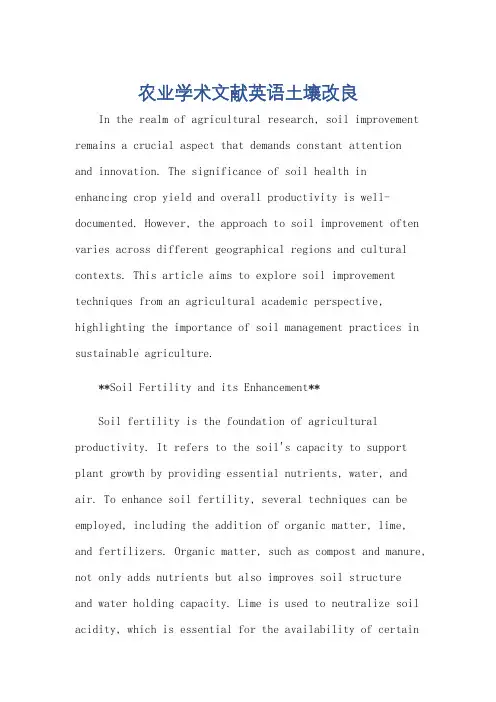
农业学术文献英语土壤改良In the realm of agricultural research, soil improvement remains a crucial aspect that demands constant attentionand innovation. The significance of soil health in enhancing crop yield and overall productivity is well-documented. However, the approach to soil improvement often varies across different geographical regions and cultural contexts. This article aims to explore soil improvement techniques from an agricultural academic perspective, highlighting the importance of soil management practices in sustainable agriculture.**Soil Fertility and its Enhancement**Soil fertility is the foundation of agricultural productivity. It refers to the soil's capacity to support plant growth by providing essential nutrients, water, and air. To enhance soil fertility, several techniques can be employed, including the addition of organic matter, lime, and fertilizers. Organic matter, such as compost and manure, not only adds nutrients but also improves soil structureand water holding capacity. Lime is used to neutralize soil acidity, which is essential for the availability of certainnutrients. On the other hand, fertilizers provide a quick source of nutrients to the soil, promoting plant growth.**Soil Conservation and Erosion Control**Soil erosion is a major threat to soil health and fertility. Wind and water erosion can lead to the loss of topsoil, reducing soil fertility and productivity. To conserve soil and control erosion, agricultural practices such as contour farming, strip cropping, and terracing are employed. These practices help in reducing water runoff and wind erosion, thus maintaining soil health and fertility. **Irrigation and Drainage Management**Effective irrigation and drainage systems are crucial for soil improvement. Adequate water supply is essentialfor plant growth, while excessive water can lead to waterlogging and soil degradation. Irrigation systems, such as drip irrigation and sprinkler systems, ensure uniform water distribution to the soil, promoting healthy plant growth. On the other hand, drainage systems help in removing excess water from the soil, preventing waterlogging and maintaining soil aeration.**Crop Rotation and Intercropping**Crop rotation and intercropping are agricultural practices that contribute significantly to soil improvement. Crop rotation involves planting different crops in the same field in successive seasons, which helps in breaking the disease cycle and preventing soil depletion. Intercropping, on the other hand, involves planting two or more crops together, which improves soil fertility by adding different nutrients and organic matter.**Soil Tillage and Mixing**Soil tillage and mixing are essential for soil improvement. Tillage helps in loosening the soil, improving aeration and water infiltration. It also mixes the soil layers, ensuring uniform distribution of nutrients and organic matter. However, excessive tillage can lead to soil erosion and degradation, thus careful consideration oftillage intensity and frequency is crucial.**Soil Monitoring and Evaluation**Soil monitoring and evaluation are integral to soil improvement. Regular soil testing helps in assessing soilfertility, pH, and nutrient status, guiding farmers in making informed decisions on soil management practices. Soil monitoring also alerts farmers to potential soil degradation issues, enabling timely corrective measures. In conclusion, soil improvement is a multifaceted process that requires a holistic approach. It involves enhancing soil fertility, conserving soil, managing irrigation and drainage, practicing crop rotation and intercropping, and monitoring soil health. As agricultural practices evolve, it is crucial to adapt soil improvement techniques to suit specific geographical and cultural contexts, promoting sustainable agriculture and environmental stewardship.**农业实践中的土壤改良:跨文化视角**在农业研究领域,土壤改良始终是一个需要持续关注和创新的关键方面。
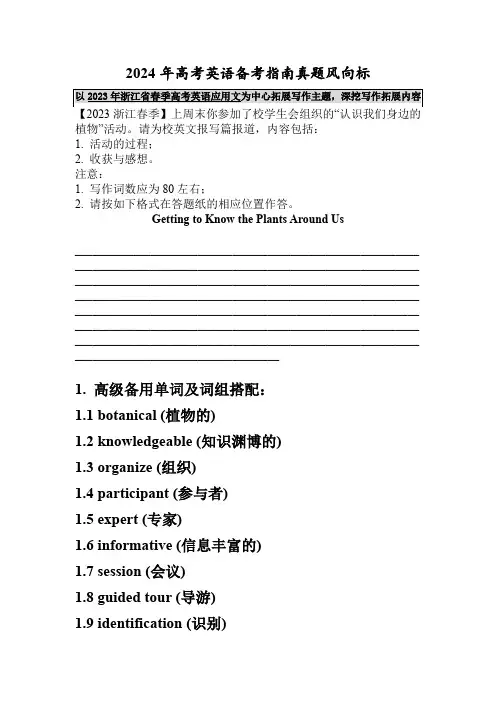
2024年高考英语备考指南真题风向标1. 高级备用单词及词组搭配:1.1 botanical (植物的)1.2 knowledgeable (知识渊博的)1.3 organize (组织)1.4 participant (参与者)1.5 expert (专家)1.6 informative (信息丰富的)1.7 session (会议)1.8 guided tour (导游)1.9 identification (识别)1.10 native species (本土物种)1.11 medicinal plants (药用植物)1.12 sustainability (可持续性)1.13 conservation (保护)1.14 ecosystem (生态系统)1.15 biodiversity (生物多样性)1.16 significance (重要性)1.17 local flora (当地植物)1.18 environmental impact (环境影响) 1.19 habitat (栖息地)1.20 interconnectedness (相互联系) 1.21 ecological balance (生态平衡) 1.22 cultivation (种植)1.23 herbaceous plants (草本植物) 1.24灌木植物(shrubs)1.25 trees (树木)1.26Blooming (开花)1.27 pollination (授粉)1.28 photosynthesis (光合作用)1.29 soil fertility (土壤肥力)1.30 water management (水资源管理) 1.31 climate change (气候变化)1.32 adaptation (适应)1.33 resilience (韧性)1.34 invasive species (入侵物种)1.35 habitat destruction (栖息地破坏)1.36 environmental awareness (环境意识)1.37 responsible consumption (负责任的消费)1.38 sustainable practices (可持续的实践)1.39 community involvement (社区参与)1.40 educational initiative (教育倡议)1.41 hands-on experience (实践经验)1.42 interactive activities (互动活动)1.43 nature appreciation (自然欣赏)1.44 outdoor learning (户外学习)1.45 lifelong learning (终身学习)1.46 cognitive development (认知发展)1.47 emotional well-being (情感健康)1.48 mental health (心理健康)1.49 holistic education (全面教育)1.50 well-rounded individuals (全面发展的人)2. 模板套句:开头:2.1 Last weekend, our school's Student Unionorganized an insightful event titled "Getting to Know the Plants Around Us."2.2 The event aimed to enhance our understanding of the botanical world and promote environmental awareness among students.2.3 With the guidance of knowledgeable experts, participants embarked on a fascinating journey to explore the diverse plant life on our campus.2.4 The event commenced with an informative session where experts shared their knowledge about various plant species and their ecological importance.2.5 Students were introduced to a wide range of native species, including medicinal plants and those that contribute to sustainability and conservation efforts.2.6 The session highlighted the significance of local flora in maintaining ecological balance and mitigating the environmental impact caused by human activities.中间行文:2.7 Following the session, participants were treated toa guided tour around the campus, where they could observe and identify different plant species in theirnatural habitat.2.8 The tour provided a hands-on experience, allowing students to appreciate the interconnectedness of plants within the ecosystem and understand their role in processes such as pollination and photosynthesis.2.9 Participants also learned about the importance of soil fertility and water management in cultivation, as well as the challenges posed by climate change and invasive species.2.10 The event emphasized the need for responsible consumption and sustainable practices, encouraging students to be mindful of their environmental footprint.2.11 Interactive activities were incorporated throughout the tour, enabling students to engage with nature and deepen their understanding of the significance of plant conservation.结尾:2.12 The event concluded with a reflection session, where participants shared their thoughts and feelings about the experience.2.13 Many students expressed gratitude for the opportunity to connect with nature and gain a deeper appreciation for the importance of plants in our lives.2.14 The event not only enriched students' knowledge about the botanical world but also inspired them to take action in protecting and preserving the environment.2.15 It was a timely reminder of the need for environmental stewardship and the collective responsibility we have in maintaining a sustainable future.2.16 The event served as an educational initiative that fostered a sense of community involvement and encouraged lifelong learning.2.17 As we continue to explore the wonders of the natural world, let us remain mindful of our role as responsible stewards and strive to create a harmonious coexistence with the plants around us.3. 精彩范文及点评:范文1:Last weekend, our school's Student Unionorganized an insightful event titled "Getting to Know the Plants Around Us." The event aimed to enhance our understanding of the botanical world and promote environmental awareness among students. With the guidance of knowledgeable experts, participants embarked on a fascinating journey to explore the diverse plant life on our campus.The event commenced with an informative session where experts shared their knowledge about various plant species and their ecological importance. Students were introduced to a wide range of native species, including medicinal plants and those that contribute to sustainability and conservation efforts. The session highlighted the significance of local flora in maintaining ecological balance and mitigating the environmental impact caused by human activities. Following the session, participants were treated to a guided tour around the campus, where they could observe and identify different plant species in their natural habitat. The tour provided a hands-on experience, allowing students to appreciate the interconnectedness of plants within the ecosystem andunderstand their role in processes such as pollination and photosynthesis. Participants also learned about the importance of soil fertility and water management in cultivation, as well as the challenges posed by climate change and invasive species.The event emphasized the need for responsible consumption and sustainable practices, encouraging students to be mindful of their environmental footprint. Interactive activities were incorporated throughout the tour, enabling students to engage with nature and deepen their understanding of the significance of plant conservation.The event concluded with a reflection session, where participants shared their thoughts and feelings about the experience. Many students expressed gratitude for the opportunity to connect with nature and gain a deeper appreciation for the importance of plants in our lives. The event not only enriched students' knowledge about the botanical world but also inspired them to take action in protecting and preserving the environment. It was a timely reminder of the need for environmental stewardship and thecollective responsibility we have in maintaining a sustainable future.点评:范文1在用词上准确地使用了高级词汇,如"insightful," "botanical," "ecological," 和"sustainability," 这些词汇有效地描述了活动的内容和目的。
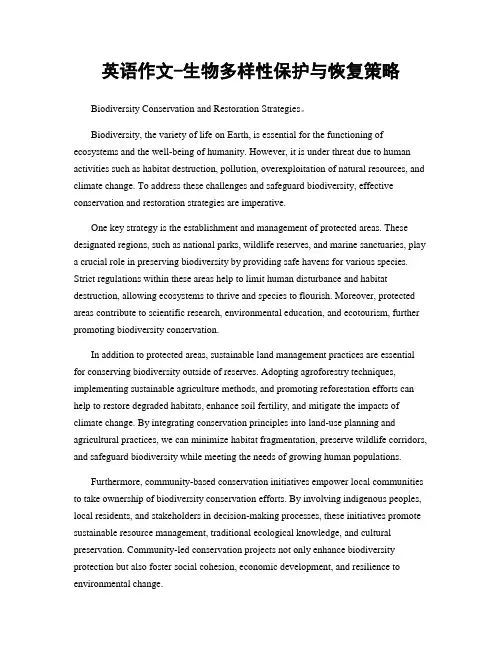
英语作文-生物多样性保护与恢复策略Biodiversity Conservation and Restoration Strategies。
Biodiversity, the variety of life on Earth, is essential for the functioning of ecosystems and the well-being of humanity. However, it is under threat due to human activities such as habitat destruction, pollution, overexploitation of natural resources, and climate change. To address these challenges and safeguard biodiversity, effective conservation and restoration strategies are imperative.One key strategy is the establishment and management of protected areas. These designated regions, such as national parks, wildlife reserves, and marine sanctuaries, play a crucial role in preserving biodiversity by providing safe havens for various species. Strict regulations within these areas help to limit human disturbance and habitat destruction, allowing ecosystems to thrive and species to flourish. Moreover, protected areas contribute to scientific research, environmental education, and ecotourism, further promoting biodiversity conservation.In addition to protected areas, sustainable land management practices are essential for conserving biodiversity outside of reserves. Adopting agroforestry techniques, implementing sustainable agriculture methods, and promoting reforestation efforts can help to restore degraded habitats, enhance soil fertility, and mitigate the impacts of climate change. By integrating conservation principles into land-use planning and agricultural practices, we can minimize habitat fragmentation, preserve wildlife corridors, and safeguard biodiversity while meeting the needs of growing human populations.Furthermore, community-based conservation initiatives empower local communities to take ownership of biodiversity conservation efforts. By involving indigenous peoples, local residents, and stakeholders in decision-making processes, these initiatives promote sustainable resource management, traditional ecological knowledge, and cultural preservation. Community-led conservation projects not only enhance biodiversity protection but also foster social cohesion, economic development, and resilience to environmental change.Moreover, addressing the underlying drivers of biodiversity loss, such as unsustainable consumption patterns and economic incentives that prioritize short-term gains over long-term sustainability, is crucial. Implementing policies that promote sustainable resource management, regulate wildlife trade, and incentivize conservation practices can help to mitigate the pressures on biodiversity and foster a more harmonious relationship between humans and the natural world.Education and awareness-raising efforts are also vital components of biodiversity conservation and restoration strategies. By promoting environmental literacy, fostering a deeper understanding of the value of biodiversity, and encouraging individual actions to protect the environment, we can mobilize collective efforts towards conservation goals. Through targeted outreach programs, environmental campaigns, and environmental education in schools, we can inspire future generations to become stewards of biodiversity and champions for sustainable development.In conclusion, biodiversity conservation and restoration are critical endeavors that require concerted efforts at local, national, and global levels. By implementing a combination of protected areas, sustainable land management practices, community-based conservation initiatives, policy interventions, and educational initiatives, we can work towards preserving Earth's rich biodiversity for present and future generations. Only through collective action and a shared commitment to stewardship can we ensure a sustainable future for all life on our planet.。
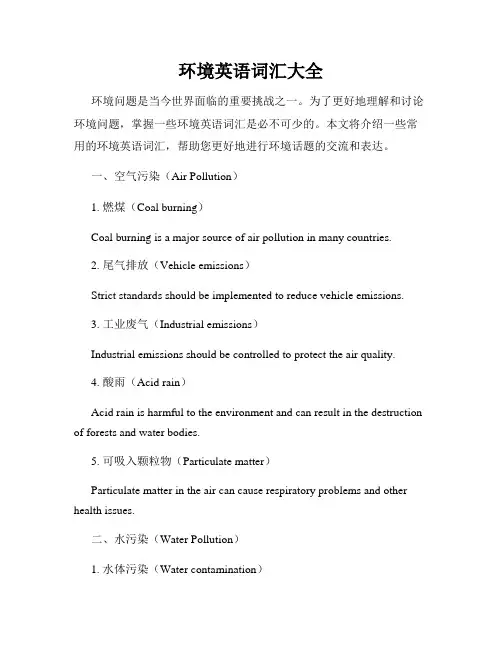
环境英语词汇大全环境问题是当今世界面临的重要挑战之一。
为了更好地理解和讨论环境问题,掌握一些环境英语词汇是必不可少的。
本文将介绍一些常用的环境英语词汇,帮助您更好地进行环境话题的交流和表达。
一、空气污染(Air Pollution)1. 燃煤(Coal burning)Coal burning is a major source of air pollution in many countries.2. 尾气排放(Vehicle emissions)Strict standards should be implemented to reduce vehicle emissions.3. 工业废气(Industrial emissions)Industrial emissions should be controlled to protect the air quality.4. 酸雨(Acid rain)Acid rain is harmful to the environment and can result in the destruction of forests and water bodies.5. 可吸入颗粒物(Particulate matter)Particulate matter in the air can cause respiratory problems and other health issues.二、水污染(Water Pollution)1. 水体污染(Water contamination)Water contamination is a serious problem that affects the health of humans and aquatic ecosystems.2. 水资源管理(Water resource management)Effective water resource management is crucial for sustainable development.3. 水生生物(Aquatic organisms)Water pollution can have detrimental effects on aquatic organisms, leading to a decline in biodiversity.4. 水处理(Water treatment)Proper water treatment is essential to remove pollutants and ensure clean and safe drinking water.5. 河流富营养化(River eutrophication)River eutrophication, caused by excessive nutrients in the water, can lead to the growth of harmful algae and fish kills.三、土壤污染(Soil Pollution)1. 化学污染物(Chemical pollutants)Chemical pollutants, such as pesticides and industrial waste, can contaminate soil and affect plant growth.2. 土壤侵蚀(Soil erosion)Soil erosion is a significant environmental issue that can lead to the loss of fertile soil for agriculture.3. 土壤酸化(Soil acidification)Soil acidification can reduce soil fertility and limit crop production.4. 土壤退化(Soil degradation)Soil degradation is the deterioration of soil quality, often caused by improper land use and overuse of agrochemicals.5. 土壤保护(Soil conservation)Soil conservation practices, such as terracing and crop rotation, are important for sustainable agriculture and preventing soil pollution.四、生物多样性(Biodiversity)1. 物种灭绝(Species extinction)The loss of biodiversity has led to an increased risk of species extinction.2. 自然保护区(Nature reserve)Nature reserves are established to protect and conserve endangered species and their habitats.3. 生态系统(Ecosystem)Ecosystems provide essential services, such as water purification and climate regulation.4. 物种多样性(Species diversity)Promoting species diversity is crucial for maintaining healthy ecosystems.5. 野生动植物保护(Wildlife conservation)Wildlife conservation efforts aim to protect endangered species and their habitats from human activities.五、可持续发展(Sustainable Development)1. 绿色能源(Green energy)Investing in green energy sources, such as wind and solar power, is essential for sustainable development.2. 环境教育(Environmental education)Environmental education plays a crucial role in raising awareness and promoting sustainable practices.3. 节约能源(Energy conservation)Energy conservation is an effective way to reduce carbon emissions and mitigate climate change.4. 循环经济(Circular economy)The concept of a circular economy promotes the reuse and recycling of resources, reducing waste and environmental impact.5. 生态足迹(Ecological footprint)Calculating ecological footprints helps individuals and organizations understand their impact on the environment and make sustainable choices.结语:以上是一些常用的环境英语词汇,希望本文能够帮助您更好地理解和表达环境话题。
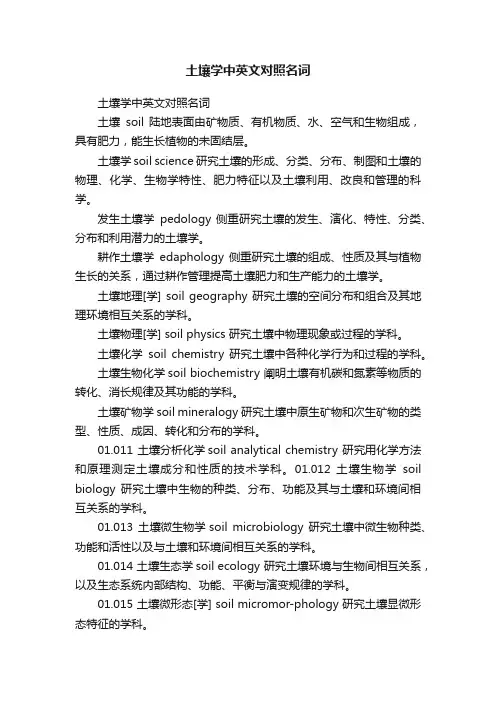
土壤学中英文对照名词土壤学中英文对照名词土壤soil 陆地表面由矿物质、有机物质、水、空气和生物组成,具有肥力,能生长植物的未固结层。
土壤学soil science 研究土壤的形成、分类、分布、制图和土壤的物理、化学、生物学特性、肥力特征以及土壤利用、改良和管理的科学。
发生土壤学pedology 侧重研究土壤的发生、演化、特性、分类、分布和利用潜力的土壤学。
耕作土壤学edaphology 侧重研究土壤的组成、性质及其与植物生长的关系,通过耕作管理提高土壤肥力和生产能力的土壤学。
土壤地理[学] soil geography 研究土壤的空间分布和组合及其地理环境相互关系的学科。
土壤物理[学] soil physics 研究土壤中物理现象或过程的学科。
土壤化学soil chemistry 研究土壤中各种化学行为和过程的学科。
土壤生物化学soil biochemistry 阐明土壤有机碳和氮素等物质的转化、消长规律及其功能的学科。
土壤矿物学soil mineralogy 研究土壤中原生矿物和次生矿物的类型、性质、成因、转化和分布的学科。
01.011 土壤分析化学soil analytical chemistry 研究用化学方法和原理测定土壤成分和性质的技术学科。
01.012 土壤生物学soil biology 研究土壤中生物的种类、分布、功能及其与土壤和环境间相互关系的学科。
01.013 土壤微生物学soil microbiology 研究土壤中微生物种类、功能和活性以及与土壤和环境间相互关系的学科。
01.014 土壤生态学soil ecology 研究土壤环境与生物间相互关系,以及生态系统内部结构、功能、平衡与演变规律的学科。
01.015 土壤微形态[学] soil micromor-phology 研究土壤显微形态特征的学科。
01.016 土壤资源soil resources 土壤类型的数量与质量。
土壤肥力的英文1. Soil fertility- 释义:土壤肥力,指土壤为植物生长提供养分、水分、空气和适宜物理环境的能力。
- 短语:maintain soil fertility(保持土壤肥力),improve soil fertility(提高土壤肥力),soil fertility assessment(土壤肥力评估)- 单词:soil(土壤),fertility(肥沃;肥力)- 用法:“The level of soil fertility affects crop yields.”(土壤肥力水平影响作物产量。
),常与一些动词搭配表示对土壤肥力的操作。
- 双语例句:Farmers use various methods to enhance soil fertility.(农民们使用各种方法来增强土壤肥力。
)2. Soil richness- 释义:土壤丰富度,与土壤肥力意思相近,强调土壤中养分等物质的丰富程度。
- 短语:evaluate soil richness(评估土壤丰富度),highsoil richness(高土壤丰富度)- 单词:richness(丰富;富裕)- 用法:“The soil richness in this area is suitable for growing a wide variety of plants.”(这个地区的土壤丰富度适合种植多种植物。
)- 双语例句:We need to protect the natural soil richness.(我们需要保护自然的土壤丰富度。
)3. Soil productivity- 释义:土壤生产力,即土壤产出农产品的能力,与土壤肥力密切相关。
- 短语:increase soil productivity(提高土壤生产力),soil productivity index(土壤生产力指数)- 单词:productivity(生产力;生产率)- 用法:“Good soil fertility is essential for high soil productivity.”(良好的土壤肥力对高土壤生产力至关重要。
Soil FertilizationSoil fertilization is a crucial practice in agriculture aimed at improving soil fertility and maximizing crop yields. It involves the addition of nutrients to the soil to compensate for any deficiencies, thereby ensuring optimal plant growth and productivity. This article will explore the importance of soil fertilization, different types of fertilizers, and some modern fertilizer application techniques.Importance of Soil FertilizationFertilizers play a vital role in maintaining soil health and fertility. The nutrients present in fertilizers promote plant growth, enhance root development, and improve resistance to diseases and pests. Additionally, they aid in the efficient use of water by plants, contributing to better irrigation practices. By replenishing the soil with essential nutrients, farmers can cultivate healthy and robust crops, ultimately increasing agricultural productivity.Types of FertilizersThere are two primary types of fertilizers: organic and inorganic.anic Fertilizers: Organic fertilizers are derived from naturalsources such as plant and animal materials. Common organic fertilizers include compost, manure, bone meal, and green manure. These fertilizers releasenutrients gradually, providing the soil with organic matter and improving its structure. Organic fertilizers are environmentally friendly, as they do notcontain harsh chemicals that could harm the ecosystem.2.Inorganic Fertilizers: Inorganic, or synthetic, fertilizers aremanufactured through chemical processes. They are typically composed ofconcentrated nutrients and are available in various forms, including liquid,granules, and powders. Inorganic fertilizers provide an immediate andconcentrated supply of nutrients to plants. However, excessive and improper use of these fertilizers can result in nutrient imbalances and environmentalpollution.Modern Fertilizer Application TechniquesTo achieve efficient nutrient distribution and minimize environmental impact, modern farming practices have introduced innovative fertilizer application techniques. Some notable techniques include:1.Precision Farming: Precision farming utilizes technologies such asGeographic Information Systems (GIS), global positioning systems (GPS), and remote sensing to optimize fertilizer application. By accurately mapping field variations, farmers can apply fertilizers at precise locations and rates, ensuring maximum nutrient uptake by plants and minimizing waste.2.Controlled-Release Fertilizers: Controlled-release fertilizers (CRFs)are designed to release nutrients slowly over an extended period. Thesefertilizers are encapsulated or coated, allowing for a gradual nutrient release and reducing the risk of leaching. CRFs are beneficial in situations whereregular fertilizer applications are challenging.3.Foliar Feeding: Foliar feeding involves spraying liquid fertilizersdirectly onto the leaves of plants. This technique allows for rapid nutrientabsorption and can be a useful method to supply nutrients during critical plant growth stages or in nutrient-deficient soils. However, foliar feeding should be used as a supplemental practice rather than a replacement for soil fertilization.ConclusionSoil fertilization is vital for maintaining soil fertility and achieving optimum crop production. Organic and inorganic fertilizers provide essential nutrients to plants, promoting growth, health, and resistance to stress. By adopting modern fertilizer application techniques such as precision farming, controlled-release fertilizers, and foliar feeding, farmers can enhance nutrient distribution, improve environmental sustainability, and maximize the efficiency of fertilizer utilization. Ultimately, proper soil fertilization practices contribute to global food security and sustainable agricultural systems.。
土壤肥力评价英语Soil fertility is a critical component of agricultural productivity. It refers to the ability of soil to provide essential nutrients to plants in adequate amounts and proportions for their growth and development. The evaluation of soil fertility involves assessing various physical, chemical, and biological properties of the soil that contribute to its overall health and productivity.Physical Properties:。
The physical properties of soil, such as texture, structure, and porosity, influence its fertility. Soil texture, determined by the proportion of sand, silt, and clay, affects water retention and air circulation. A well-structured soil with good porosity allows for proper root growth and microbial activity, which are vital for plant nutrition.Chemical Properties:。
Chemical analysis of soil includes measuring pH levels, electrical conductivity, and the concentration of macro and micronutrients. The pH level of soil affects nutrient availability, with most nutrients being readily available in slightly acidic to neutral soils. Electrical conductivity provides an estimate of the soil's salinity, which can impact plant growth. Essential nutrients like nitrogen, phosphorus, and potassium, along with micronutrients such as iron, manganese, and zinc, must be present in optimal quantities for plants to thrive.Biological Properties:。
土壤污染的后果短篇英文作文Soil Pollution: The Devastating ConsequencesSoil pollution is a pressing environmental issue that has far-reaching consequences for both human and ecological well-being. This insidious form of contamination can have detrimental effects on the very foundation of our existence – the soil that sustains our food production, supports our ecosystems, and provides a vital resource for countless living organisms. The impacts of soil pollution are multifaceted and can be catastrophic if left unaddressed.One of the primary concerns with soil pollution is its impact on food security. Arable land is a finite resource, and the degradation of soil quality through pollutants can severely limit our ability to grow nutritious crops. Contaminated soils may accumulate heavy metals, pesticides, or other toxic substances that can be absorbed by plants, ultimately entering the human food chain. Consuming produce grown in polluted soil can lead to a range of health problems, including neurological disorders, organ damage, and even cancer.Moreover, soil pollution can have devastating consequences for the delicate balance of ecosystems. The introduction of foreignsubstances into the soil can disrupt the intricate web of life that thrives in the earth's biosphere. Beneficial microorganisms, essential for maintaining soil fertility and nutrient cycling, may be destroyed or displaced, leading to a cascading effect on the entire ecosystem. This can result in the loss of biodiversity, the decline of pollinator populations, and the disruption of natural habitats that countless species rely on for their survival.One of the most insidious aspects of soil pollution is its persistence. Many pollutants, such as heavy metals and persistent organic compounds, can remain in the soil for decades, if not centuries, posing a continuous threat to the environment and human health. This long-term contamination can have far-reaching consequences, as the pollutants can leach into groundwater, contaminate surface water, and accumulate in the tissues of living organisms, including the food we consume.The sources of soil pollution are diverse and often the result of human activities. Industrial processes, agricultural practices, waste disposal, and even the use of certain household products can all contribute to the degradation of soil quality. The improper handling and disposal of hazardous materials, the overuse of pesticides and fertilizers, and the release of pollutants from transportation and energy production all play a significant role in the growing problem of soil pollution.Addressing the issue of soil pollution requires a multifaceted approach that involves both individual and collective action. On an individual level, consumers can make informed choices about the products they use, support sustainable agricultural practices, and participate in local initiatives to clean up contaminated areas. Governments and policymakers must also take a leading role in developing and enforcing strict regulations, investing in research and development, and promoting sustainable land management practices.Ultimately, the consequences of soil pollution are far-reaching and can have lasting impacts on our environment, our health, and our ability to sustain life on this planet. By recognizing the gravity of this issue and taking concerted action to mitigate soil pollution, we can protect the foundation of our existence and ensure a more sustainable future for generations to come.。
介绍土地资源管理专业的英语作文范文Land resource management is a specialized field that deals with the sustainable and efficient use of land for various purposes, such as agriculture, forestry, urban development, and conservation. It involves the planning, monitoring, and regulation of land use to ensure that it is used in a way that benefits society and the environment.One of the key aspects of land resource management is land-use planning, which involves determining the best use of land for different purposes based on factors such as soil fertility, climate, topography, and the needs of the local community. This can involve creating zoning regulations, land-use maps, and other tools to guide development and preservation efforts.Another important aspect of land resource management is natural resource conservation, which involves identifying and protecting important ecosystems, habitats, and biodiversity hotspots. This can involve establishing protected areas, implementing conservation programs, and working with local communities to promote sustainable land use practices.In addition to land-use planning and conservation, land resource management also involves monitoring the health andproductivity of land resources, such as soil quality, water availability, and vegetation cover. This can involve collecting and analyzing data on land use and ecological conditions, conducting field surveys, and using remote sensing technologies to track changes in the landscape over time.A career in land resource management can be diverse and rewarding, offering opportunities to work in government agencies, non-profit organizations, consulting firms, and research institutions. Professionals in this field may work on a wide range of projects, from developing land-use plans for national parks to conducting field studies on the impacts of land degradation on water quality.To succeed in land resource management, individuals need to have a strong understanding of environmental science, geographic information systems (GIS), land-use planning principles, and natural resource management techniques. They also need to have good communication skills, problem-solving abilities, and a passion for protecting and preserving the environment.In conclusion, land resource management is a vital field that plays a crucial role in ensuring the sustainable and responsible use of land for the benefit of current and future generations. Bypursuing a career in this field, individuals can make a positive impact on the environment and contribute to the conservation and wise management of our precious land resources.。
关于保护英文作文的句型Title: The Imperative of Safeguarding Our Planet.In the grand scheme of the universe, our planet Earth stands as a unique and fragile oasis, teeming with diverse life forms and rich ecosystems. Its natural resources and ecological balance are integral to our survival and well-being. However, the relentless pursuit of economic growth and technological advancement has taken a heavy toll on our environment, leading to widespread degradation and depletion. The time is ripe for us to集体recognize the urgency of protecting our planet and take concerted action to safeguard its ecological integrity.One of the most pressing challenges we face is climate change. The relentless emission of greenhouse gases into the atmosphere has led to a steady rise in global temperatures, causing extreme weather events, melting ice caps, and rising sea levels. The impact of these changes is already being felt across the globe, with droughts, floods,and storms wreaking havoc on human settlements and natural habitats. To mitigate the worst impacts of climate change,it is imperative that we transition to renewable energy sources, reduce our carbon footprint, and adopt sustainable practices in all aspects of our lives.Another crucial aspect of environmental protection isthe preservation of biodiversity. The rich diversity of species and ecosystems found on our planet is not just a source of beauty and wonder but also crucial for our survival. Biodiversity supports essential ecological functions like pollination, soil fertility, and climate regulation. However, human activities such as deforestation, pollution, and overexploitation have led to a rapid decline in biodiversity, pushing many species to the brink of extinction. It is crucial that we halt this trend and conserve our natural heritage by implementing strict environmental laws, promoting sustainable development, and encouraging public awareness and participation.Moreover, we must also focus on sustainable resource management. Our planet's natural resources are finite, andtheir unsustainable exploitation is leading to severe environmental degradation and social injustice. The overexploitation of water, soil, and forests has led tosoil erosion, water scarcity, and deforestation, affecting the livelihoods of millions. To ensure sustainable development, we need to adopt resource-efficient technologies, promote circular economies, and encourage conservation practices at all levels.In addition, we must recognize that environmental protection is a shared responsibility. Governments, businesses, communities, and individuals must come together to create a movement for environmental sustainability. Governments should implement policies that prioritize environmental protection, businesses should adopt sustainable practices, communities should promote environmental education and awareness, and individuals should make eco-friendly choices in their daily lives.In conclusion, the protection of our planet is not just a responsibility but also an imperative for our future. The challenges we face are immense, but the solutions arewithin our grasp. By acting together and adopting sustainable practices, we can ensure a healthy and vibrant planet for ourselves and future generations. Let us rise to this challenge and create a legacy of environmental protection and sustainability.。
Resource management,soil fertility and sustainablecrop production:Experiences of ChinaH.S.Yang*Department of Agronomy and Horticulture,University of Nebraska,Lincoln,P.O.Box830915,Lincoln,NE68583-0915,USAAvailable online16May2006AbstractChina is unique for its long history of permanent arable farming,large population,low per capita natural resources,and at the same time, having largely achieved food self-sufficiency.Some of the experiences of Chinese farming may provide clues or alternatives to other resource-poor countries in their strive for optimizing utilization of natural resources,improving soil fertility,and increasing food production.China’s experiences are summarized intofive attributes:(1)farmer’s strong awareness of the importance of organic manuring in soil fertility and productivity,(2)exploration of all possible organic resources for recycling,(3)maximization of resource use efficiency,(4)crop rotation and cropping intensification,and(5)irrigation and use of chemical fertilizers.Chinese farmers regard almost all forms of organic wastes as ‘organic treasures’,and recycle them into organic fertilizers through animal digestion and/or composting.Biogas generation using organic wastes is explored as an extra step in this process.Recycling of organic wastes through animals and biogas generation utilizes effectively the part of organic carbon that can be converted directly to food and useful energy,which would otherwise be quickly lost in the early phase of decomposition in soil or compost.Crop rotation with legumes helps restore and balance soil nutrient supply.Multiple cropping is effective in boosting crop production from limited arable land.Cropping intensification,however,requires external nutrient inputs from chemical fertilizers,and in many places,also ernment support proved critical in the development of agricultural infrastructure as well as in overall crop production.#2006Elsevier B.V.All rights reserved.Keywords:China;Manuring;Resource management;Soil fertility;Sustainable crop production1.IntroductionMaintaining soil fertility is vital for sustainable soil productivity,especially in resource-poor countries.While food shortage and malnutrition are still seen in many parts of the world(FAO,2003a),tackling the problem requires not only short-term remedies,but also long-term solutions that are ecologically sound and compatible with local natural and socio-economic configurations(Rosegrant et al.,2001). China is unique for its long history of permanent arable farming,large population,low per capita natural resources, and at the same time,is an example of having largely achieved food self-sufficiency(FAO,2000).China’s permanent arable farming of cereal crops began at least3000years ago along the middle and lower reaches of the Yangtze River and Yellow River(King,1911;Xu and Peel,1991;Li,2001).The land has been cultivated continuously for centuries in some places(Li and Sun, 1990;Ellis and Wang,1997).Cereal crops,including rice (Oryza sativa L.),wheat(Triticum aestivum L.),maize(Zea mays L.),sorghum(Sorghum bicolor L.)and millet (Pennisetum glaucum L.),have traditionally been the major foodstuff for Chinese.On the other hand,the long history of arable farming and ever increasing population have resulted in depletion of arable land reserve(Li and Sun,1990).While the population has more than doubled since the1950s to its current1.3billion,the total arable land has expanded only 29%to the current136million ha(FAO,2002).In a global perspective,China’s population accounts for21%of the/locate/ageeAgriculture,Ecosystems and Environment116(2006)27–33*Tel.:+14024721566;fax:+14024727904.E-mail address:hyang2@unl.ed.0167-8809/$–see front matter#2006Elsevier B.V.All rights reserved.doi:10.1016/j.agee.2006.03.017world,while its share of arable land is only9%.At present, China’s per capita arable land is0.1ha,which is45%of the world average and half of the rest of the developing countries(Table1).Despite of the limited land resources,cereal production in China has seen markedly growth in the last four decades (FAO,2000).Annual cereal production raised from around 110million Mg in early1960s to an average of421million Mg during the1990s.The growth is attributed mainly to the near four-fold increase in crop yields per land area(Fig.1).Per capita calorie supply,an important index of basic living standard,has increased to over3000kcal per day,almost doubled in four decades even with the double increase in population.The objective of this paper is to review some of the agricultural experiences in China that have contributed greatly to the significant improvement in China’s food security.The experiences can be summarized intofive attributes:(1)farmer’s strong awareness of the importance of organic manuring in soil fertility and productivity,(2) exploration of all possible organic resources for recycling, (3)maximization of resource use efficiency,(4)crop rotation and cropping intensification,and(5)irrigation and use of chemical fertilizers.The experiences may provide clues or alternatives to other resource-poor countries in their strive for optimizing utilization of natural resources,improving soil fertility and food security.2.China’s experiences2.1.Manuring as a tradition of farmingTraditional Chinese farming emphasizes organic manur-ing,which is understood by modern soil science to be essential for maintaining soil organic matter,soil fertility and productivity.One of the Chinese farming proverbs says ‘Farming is a joke without manuring’.Many ancient Chinese articles have the mention of applying human and animal excreta to thefield.For example,Han Feizi(280–233B.C.) wrote in‘Lao Jie’that human excreta must be applied in order to restore and improve soil‘strength’(a Chinese term for soil fertility).Throughout the farming history,farmers are taught from one generation to another that manures are both the food for crops and the remedies for soil problems (Yu et al.,1980).Farmers also regard organic manuring as a short-term investment(i.e.,for the current crops)as well as a long-term investment(i.e.,for soil fertility).Before the era of chemical fertilizers,farmers relied solely on organic manuring to maintain soil fertility and to support permanent arable farming(Li and Sun,1990;Ellis and Wang,1997).Farmers usually apply manures in the beginning of a growing season prior to plowing.They also know the importance of placing manures close to crop stands.For instance,when manures are insufficient for the wholefield,H.S.Yang/Agriculture,Ecosystems and Environment116(2006)27–3328Table1China’s population,arable land area(including permanent crop land)and per capita share in1961and2000in comparison with the developing countries (excluding China)and the world19612000Population (million)Arable land(million ha)Arable landper capita(ha)Population(million)Arable land(million ha)Arable land percapita(ha)China6691050.1612751360.11 Developing countries14275710.4034677210.21 World307913470.44605714970.25 Source:FAO(2002).Fig.1.Yield of cereal crops(A),per capita cereal production(B)and percapita calorie supply(C)of China in comparison with the developingcountries(excluding China)and the world in the last four decades.Datasource:FAO(2002).farmers usually place manures directly into planting rows or pits.In addition,farmers have traditionally used manuring as an effective means to improve soil workability,tilth and water holding capacity(Li and Sun,1990).Organic manuring is probably the key practice that has supported permanent arable farming in China for centuries(Chen, 1990).Use of manures remained an important farming practice even after chemical fertilizers became widely available(Fig.2).However,the proportion of manures in overall nutrient supply has declined significantly in recent years,as a results of increase in use of chemical fertilizers (Gao et al.,2000)and the decline in use of manures.For instance,He and Xie(2000)report decline in use of manure in many areas in Guangxi(southwest)in the last decade, while Chen and Liu(2003)report similar observations in Liaoning(Northeast).2.2.Exploration of resources for manuringUnlike chemical fertilizers which have definitive forms and composition,manures can virtually be any organic wastes that contain crop nutrients and are decomposable.In the eyes of Chinese farmers,organic wastes are‘organic treasures’that have the magic to turn their hard work into a good harvest.The way Chinese farmers value organic wastes is described as‘religious’by early western visitors to China (Sanders,2000).Exploring resources for manuring is more like a treasure hunting.Collecting animal and human wastes and composting them are an important part of farm work.In rural areas,almost all household wastes,human and animal wastes are eventually collected and recycled to thefield(Yu et al.,1980).In urban areas,most of the human and household wastes are collected by farmers in surrounding rural areas.In recent years,however,the practice of recycling household wastes forfield use,especially from urban areas,has become unpopular,due partly to the growing presence of indecomposable solid materials (mainly plastic and glass)in the wastes and increasing labor costs.Periodical clearing of shallow water bodies,such as ponds,lakes or seasonal rivers,not only helps inflood control and improve irrigation,the mud is also an excellent soil amendment and fertilizer(Li,2001).In northern China where winter is a long off-season,organized clearing of seasonal rivers and cannels used to be common during the commune era(from late1950s to early1980s), and the mud benefited greatly nearby farmland.Mud fromfishing ponds is especially seen as one of the best organic fertilizers.Domestic animals,including pig,cattle,poultries and evenfish,have long played a big role in turning organic materials to precious fertilizers while producing useful products including farm power.Through the animals,a wide range of plant materials,including crop residues,weeds and grasses from non-farm land,are recycled eventually as fertilizers into farmland.This is an important source of external nutrient inputs to farmland(Li et al.,1988).2.3.Maximization of resource utilizationMaximum utilization of available resources is vital for farming systems that do not have significant external material and energy inputs.The hardship of making a living has taught Chinese farmers that every piece of natural resources must be utilized with high efficiency.To achieve that,the usable energy and nutrients in the primary resources (i.e.,plant materials)must be converted as much as possible into useful products as food,fuel and working power before those materials arrive in thefield as fertilizers.For instance, farmers typically keep two or three kinds of animals in their households:cattle or horse for consuming cellulose-rice materials such as crop residues,and poultries for tender weeds and waste food.Pig andfish are typically fed on almost everything,including waste food,weeds,and even wastes from other animals.Energy shortage in rural areas of China has been one of the key factors that hinder rural development(Deng,1995). The traditional reliance on crop residues for domestic fuel in many rural areas has the drawback of competing with the soil for nutrients as well as for organic matter.Since the 1970s,in particular during the1980s and1990s,biogas generation from crop residues and organic wastes has received widespread attention(Marchaim,1992;Wang and Gao,2003).Li(2001)estimates that approximatelyfive million farm households in China had anaerobic digesters by the late1990s,with the majority in the south where the climate is warmer and raw materials are abundant.Yang (2001)reports that9.5%of the rural households in Jiangxi Province in southeast have anaerobic digesters.In the wave of rapid development of intensive animal production and fast pace of urbanization,biogas generation could become an effective means to achieve integrated use of animal and domestic wastes while easing the energy shortage and improving sanitation in many rural areas(Zeng,2000;Wang and Ren,2002).H.S.Yang/Agriculture,Ecosystems and Environment116(2006)27–3329Fig.2.Application rates of organic and chemical fertilizers in China since the1950s.The rates are based on N for nitrogen,P2O5for phosphorous,and K2O for potassium.Data source:IIASA(2002).Biogas generation makes efficient use of the energy in the raw materials while preserving most nutrients that are usable to crops.It also greatly improves energy use efficiency asmuch as six fold compared with direct burning(The United Nations University,1979).In contrast,when plant materials are retuned directly to the soil,60–80%of the carbon is lost in thefirst year along with the energy they carry in the process of decomposition(Fig.3).In farming systems where natural resources are limited,such an integrated exploration of energy and nutrients is more attractive and sustainable than direct return of crop resides.Implementing such a scheme,however,requires extra labor as well as knowledge and skills.In addition,extension education and govern-mental support often play a critical role in making it viable (Deng,1995;Zhang,2000).2.4.Cropping intensification and crop rotationThe limited land resources for arable farming is one of the struggles China has faced for centuries(Zhao,1989). Farmers’solution to this problem is to grow more than one crop in the samefield each year,known as multiple cropping.Depending on local conditions,including climate and irrigation,either relay(or inlaid)cropping or sequential (or successive)cropping is practiced(Liu and Mu,1988).In a relay cropping system,a second crop is planted before harvesting thefirst crop;in a sequential cropping system,a second crop is planted immediately after harvesting thefirst crop.Two sequential crops a year is the dominant form in the last two decades(Fig.4),especially in the south where winter is short and mild(Liu and Mu,1988).Maize followed by winter wheat dominates in the north,whereas two crops of rice or rice followed by an upland crop is more common in the south.Three crops a year is currently practiced on one fifth of China’s arable land along the coast in southeast and south,where winter is very mild and rainfall is abundant. Nationwide the average multiple cropping index is around 156%(Fig.4).Crop rotation is another measure farmers have long used to sustain and improve soil fertility and productivity. Rotation of cereals with legumes such as soybean or mung bean used to be a common practice before chemical fertilizers were widely available(Liu and Mu,1988).Crop rotation has several positive effects,including controlling diseases,insects and pests,balancing nutrients,improving soil physical properties,and restoring and improving overall soil fertility(Xing et al.,1991;Torbert et al.,1996;Zhu et al.,2000;Huang et al.,2003).Rotation with legumes also provides diverse foodstuff for farmers and increases farm income due to higher market values of the beans.e of chemical fertilizers and irrigation,and support from pro-farming industriesIn any ecosystems,the primary productivity is ultimately limited by the resources that are available,including water, nutrients and time(i.e.,the length of growing season).Not only must those needs be met,but also at times they are needed.The later is particularly true for water.As monsoon climate dominates in most part of China,the annual rainfall typically concentrates in summer’s3–4months,while severe spring drought is common,especially in the north. Meanwhile,the long-time high cropping intensity has put a great pressure on soil fertility and nutrient anic matter content in top soil(0to15–20cm)of arablefields is typically around10g kgÀ1in the north where upland crops dominate,and15–25g kgÀ1in the south where rice is the major crop(Li and Sun,1990;Yang and Janssen,1997;Zhou et al.,2003).Such a level of basic soil fertility is regarded inadequate to sustain crop production at high intensity and to meet China’s increasing demand for crop production(Gao et al.,2000;Wang et al.,2002).As a result,irrigation has been an important part of farming in many parts of China,not only in the north but in the south as well.Some large irrigation systems,including reservoirs and cannels,were built centuries ago and are still in operation(FAO,2003b).For example,the renowned Dujiangyan irrigation system in southeast was built around 256–151B.C.and is still serving more than half million hectares of farmland.During early1960s to early1980s, agricultural investment to irrigation infrastructure was oneH.S.Yang/Agriculture,Ecosystems and Environment116(2006)27–3330Fig.3.Mineralization of typical green manure,cereal straw and farmyard manure(FYM)in soil underfield conditions.Data source:Janssen(1992).Fig.4.Multiple cropping index in China as of1993.Data source:FAO (2002).of the priorities in government policy(Fig.5).During the 1990s,however,the investment declined significantly,due largely to the change from commune system to household management and other policy changes in agriculture.To a certain extent,the vast national investment in irrigation during the1960s to early1980s built a solid foundation for boosting China’s crop production in the last two decades, and contributed enormously to the success of China’s agriculture(Hu,1997;Zhu,2004).Chemical fertilizers,especially of nitrogen(N),are seen by farmers as a modern miracle for boosting crop growth,and were quickly adopted in the1960s and1970s.But production and supply had been a bottleneck until mid1980s(Institute of Sci-Tech Information,1992;Mao,2000).In the1960s,the government adopted the strategy of manufacturing in small scales at local levels with simple technologies.As a result, more than1200small fertilizer plants were put into operation by early1980s,producing30million Mg of NH4HCO3 (or approximately5million Mg of N).In late1970s,the government imported13fertilizer production plants from US, Japan and Europe with a total annual production capacity of 0.6million Mg of urea(Xu and Peel,1991).By late1990s, China produced annually28.7million Mg(effective nutri-ents)of chemical fertilizers with76%as N fertilizers(Mao, 2000).With such an increase in production,use of chemical fertilizers in crops has seen steep increase,reaching a national average of260kg haÀ1yearÀ1in late1990s(Fig.6).Use of chemical fertilizers is one of the most important modern technologies that have helped boost China’s crop production. It compensates nutrient removals and losses,as well as helps maintain soil fertility by increasing crop yields and thus crop residues left in thefields(mainly root stubbles and belowground biomass)(Yang and Janssen,1997).3.The test of sustainabilityThe unprecedented scale and intensity of modern arable farming in China mean extensive external inputs of energy and materials.This has generated some severe adverse impacts on the environment,people’s health,and overall social-economic development(Wen et al.,1992;Rozella et al.,1997;Zhu and Chen,2002;Tong et al.,2003).Those impacts,along with the transitional nature of China’s social, political and economic systems in the last two decades,have sparked heated debate about sustainability of China’s agriculture and even the health of China’overall economic development(Wen and Pimentel,1992;Cai and Smit,1994; Brown,1995;Alexandratos,1997;Ellis and Wang,1997; Paarlberg,1997;Rozelle and Rosegrant,1997).Two issues that are direct results of arable farming and occur in a large scale,are discussed below.They serve as a reminder to other resource-poor developing countries for more comprehensive and balanced strategies when striving for food security and improvement in quality of life.Thefirst issue is the sever soil and water erosion in the Loess Plateau and many mountainous areas in southern China.This is largely the consequence of over-expansion of arable land into marginal land and grassland,as well as deforestation(Huang,2000;Cheng,2001).This has caused a large scale of environmental damage to water bodies,air and overall ecosystems(Smil and Mao,1998; Wang,2004).Solving this problem may require funda-mental measures,including regional agricultural restruc-turing(Zhang,2001;Yang et al.,2003;Jiang,2004),and restoration of the erosion-prone arable land to grassland or forest(Cheng,2001;Xu et al.,2003).Other measures include adoption of technologies that conserve soil and water,e.g.,organic manuring to improve soil physical properties,fallow crops to cover soil surface,terracing and no-till(Wen et al.,1992;Lal,2000;Wu et al.,2004;Feng et al.,2005).The second pressing issue is the excessive accumulation of NO3-N in soil profile below rooting depth and its pollution to groundwater and surface water.This is due largely to unbalanced and excessive use of N fertilizers(Zhang et al., 1996;Zhu and Chen,2002;Cassman et al.,2003;Gu et al., 2003;Zhang et al.,2004a,b).Chen et al.(2004)report thatH.S.Yang/Agriculture,Ecosystems and Environment116(2006)27–3331Fig.5.Proportion of irrigated area in total cropland in China in comparison with the developing countries(excluding China)and the world.Data source: FAO(2002).Fig.6.Rate of chemical fertilizer use in arable land(including permanent crop land)in China in comparison with the rest of developing countries, Europe,North America and the world.The rates are based on N for nitrogen, P2O5for phosphorous,and K2O for potassium.Data source:FAO(2002).manyfields for cash crops received N rates as much asfive times the crops require,and Zhang et al.(1996)report N rates of500to1900kg haÀ1yearÀ1in many places.This concurs while organic manuring becomes less popular(Hu, 1997;Gao et al.,2000;Cao et al.,2002;Chen et al.,2003). Soil organic matter content has seen declining in many places and N use efficiency is typically below40%.In addition,potassium deficiency in arable land has become common across the country(Gao et al.,2000;Sheldrick et al.,2003;Chen et al.,2004;Dobermann et al.,2004). There is an urgent need for extension education on rational use of N fertilizers and the detrimental impacts of N loss on the environment and human health(Gao et al.,2001),as well as the indispensable role of organic manuring in improving nutrient balance and overall nutrient use efficiency.At the same time,practices of ecological agriculture should be promoted for integrated resource utilization and sustainable crop production(Wen and Pimentel,1992;Liu,2001;Huang et al.,2002).4.ConclusionTraditional Chinese farming emphasizes integrated and efficient utilization of natural resources based on local conditions.Thefive attributes described above have made a large contribution to China’s success in achieving food security to onefifth of the world population using less than one tenth of the global cropland resources.Other factors that have contributed to the success include improvement of transportation infrastructure,agricultural research and extension,and overall socio-economic reform and devel-opment(FAO,2000).On the other hand,the success China has achieved in food production also is facing a stringent test of sustainability.ReferencesAlexandratos,N.,1997.China’s consumption of cereals and the capacity of the rest of the world to increase exports.Food Pol.22,253–267. Brown,L.R.,1995.Who will feed China?Wake-up call for a small planet.In:Environmental Alert Series.World Watch Institute,W.W.Norton& Company,Inc.,New York.Cai,Y.,Smit,B.,1994.Sustainability in Chinese agriculture:challenge and hope.Agric.Ecol.Environ.49,279–288.Cao,F.,Wang,G.,Zhu,J.,2002.Monitoring of fertilizer input to farmland and analysis of nutrient balance.Soil Fert.2002(2),18–21(in Chinese). Cassman,K.G.,Dobermann,A.,Walters,D.T.,Yang,H.S.,2003.Meeting cereal demand while protecting natural resources and improving envir-onmental quality.Annu.Rev.Environ.Resour.28,10.1–10.44. Chen,H.,Wang,L.,Ding,F.,Liu,K.,2003.Change of soil nutrients from1979to1999in Liaoning Province.Chin.J.Soil Sci.34,271–275 (in Chinese).Chen,Q.,Zhang,X.,Zhang,H.,Christie,P.,Li,X.,Horlacher,D.,Liebig,H.P.,2004.Evaluation of current fertilizer practice and soil fertility invegetable production in the Beijing region.Nutr.Cycl.Agroecosys.69, 51–58.Chen,Y.B.,1990.Promoting development of organic fertilizers and settinga new stage for soil science and fertilization.Chin.J.Soil Sci.21(1),1–6(in Chinese).Chen,Z.,Liu,J.,2003.Changes of nutrients in topsoil of farmland in Tieling area,Liaoning Province.Chin.J.Soil Sci.34,77–78(in Chinese). Cheng,X.,2001.Relationship between agriculture,ecological deteriora-tion,restoration and reconstruction in Loess Plateau region of Northwest China.Sci.Agric.Sinica34,84–90(in Chinese).Deng,K.,1995.Renewable energy benefits rural women in China.In: Goldemberg,J.,Johansson,T.B.(Eds.),Energy as an Instrument for Socio-Economic Development.UNDP,New York.Dobermann,A.,Buresh,R.J.,Peng,S.B.,Witt,C.,Wang,G.H.,Huang,J.L., Yang,J.C.,Zhong,X.H.,Zou,Y.B.,2004.Strategies for increasing nitrogen use efficiency in irrigated rice systems of China.In:Proceed-ings of the paper presented at the International Conference on Resource Management for Sustainable Intensive Agriculture Systems.Promoting Environmentally Friendly Agricultural Production in China,Beijing, China,5–7April.Ellis,E.C.,Wang,S.M.,1997.Sustainable traditional agriculture in the Tai Lake region of China.Agric.Ecosyst.Environ.61,177–193. Feng,Z.,Yang,Y.,Zhang,P.,Li,Y.,2005.Grain-for-green policy and its impacts on grain supply in West nd Use Pol.22,301–312. FAO,2000.The State of Food and Agriculture2000.Rome.FAO,2002.FAOSTAT On-line Statistical Service(). FAO,2003a.World Agriculture:Towards2015/2030.An FAO Perspective.Earthscan Publications Ltd.,London.FAO,2003b.The State of World Land,Water and Plant Nutrient Resources: People’s Republic of China.Rome./ag/agl/swlwpnr/ reports/y_ea/z_cn/home.htm.Gao,X.,Ma,W.,Cui,Y.,Wang,R.,Zhang,F.,2000.Changes of soil nutrient contents and nutrient inputs in arable land of China.Plant Nutr.Fertil.Sci.6,363–369(in Chinese).Gao,Z.,Ma,W.,Du,S.,Zhang, F.,Mao, D.,2001.Current status and problems of fertilization in China.Chin.J.Soil Sci.32,258–261 (in Chinese).Gu,Q.,Yang,X.,Sun,B.,Ma,L.,2003.Effect of long-term fertilization on distribution and accumulation of NO3-N in upland loess soil.Agric.Res.Arid Areas21,48–52(in Chinese).He,W.,Xie,Z.,2000.Change in soil fertility on major paddyfields in Guangxi region.Chin.J.Soil Sci.31,24–26(in Chinese).Hu,W.,1997.Household land tenure reform in China:its impact on farming land use and nd Use Pol.14,175–186. Huang,J.K.,nd degradation in China—erosion and salinity.A report submitted to World Bank.Center for Chinese Agricultural Policy, Chinese Academy of Agricultural Sciences.Huang,M.B.,Shao,M.G.,Zhang,L.,Li,Y.S.,2003.Water use efficiency and sustainability of different long-term crop rotation systems in the Loess Plateau of China.Soil Till.Res.72,95–104.Huang,S.,Jin,J.,Yang,L.,Zuo,Y.,Cheng,M.,2002.Effect of regionalized and balanced fertilization technique on nitrogen fertilizer utilization efficiency and soil nutrient balance.Soil Fertil.2002(6),3–7 (in Chinese).IIASA(International Institute for Applied Systems Analysis)2002.http:// www.iiasa.ac.at.Institute of Sci-Tech Information,1992.Handbook of Chemical Fertilizers.Production Circulation and Application.Ministry of Chemical Industry, Beijing,China.Janssen,B.H.,anic Matter and Soil Fertility.Wageningen Agri-cultural University,Wageningen.Jiang,Z.,2004.Regional agroecological zoning and land use in China.J.China Agric.Resour.Region Plann.25(1),7–10(in Chinese). King,F.H.,1911.Farmers of40Centuries,Tenth ed.Gutenberg Ebook,In: /pages/kingfhetext04frftc10/-1.html.Lal,R.,2000.Soil management in the developing countries.Soil Sci.165, 57–72.Li,W.H.,2001.Agro-ecological farming systems in China.UNESCO. Li,C.K.,Sun,O.,1990.Soils of China.Science Press,Beijing.H.S.Yang/Agriculture,Ecosystems and Environment116(2006)27–33 32。